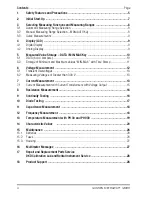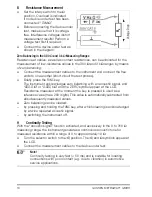
16
GOSSEN METRAWATT GMBH
8
Resistance Measurement
➭
Set the rotary switch to the
Ω
position. Overload is indicated
if no device under test has been
connected: “
0.L
M
Ω
”.
➭
Before connecting the device under
test, make sure that it is voltage-
free. Interference voltages distort
measurement results! Perform a
voltage test first if required.
➭
Connect the device under test as
shown in the diagram.
Zero Balancing in the 300
Ω
and 3 k
Ω
Measuring Ranges
Resistance at cables, as well as contact resistances, can be eliminated for the
measurement of low-resistance values in the 300
Ω
and 3 k
Ω
ranges by means
of zero balancing:
➭
Connect the measurement cables to the instrument and connect the free
ends to one another (short circuit the test probes).
➭
Briefly press the
FUNC
key.
The instrument acknowledges zero balancing with an acoustic signal, and
“
000
.
0
Ω
” or “
0
.
000
k
Ω
”
and the ZERO symbol appear at the LCD.
Resistance measured at the moment the key is pressed is used as a
reference value (max. 200 digits). This value is automatically subtracted from
all subsequently measured values.
➭
Zero balancing can be cleared:
–
by pressing and holding the
FUNC
key, after which clearing is acknowledged
by a twice repeated acoustic signal,
–
by switching the instrument off.
9
Continuity Testing
With the “acoustic signal” function activated, and exclusively in the 0 to 310
Ω
measuring range, the instrument generates a continuous acoustic tone for
measured resistance within a range of 0 to approximately 10
Ω
.
➭
Turn the selector switch to the
position. The
and
Ω
symbols appear at
the LCD.
➭
Connect the measurement cables to the device under test.
Note!
☞
Continuity testing is very fast (< 50 ms) and is suitable for locating
connections with poor contact (e.g. due to vibration) in automotive
service applications.
R
x
Vo
ltage D
ro
p












































